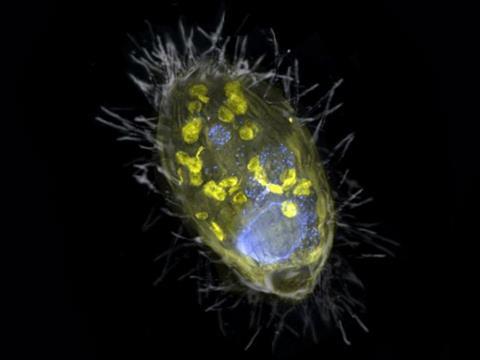In 2021, scientists at the Max Planck Institute for Marine Microbiology in Bremen, Germany, reported an astonishing new form of symbiosis: They found a unique bacterium that lives inside a ciliate – a unicellular eukaryote – and provides it with energy. The symbiont’s role is thus strongly reminiscent of mitochondria, with the key difference that the endosymbiont derives energy from the respiration of nitrate, not oxygen.

Now the researchers from Bremen have set out to learn more about the environmental distribution and diversity of these peculiar symbionts.
“After our initial discovery of this symbiont in a freshwater lake, we wondered how common these organisms are in nature,” says Jana Milucka from the Max Planck Institute for Marine Microbiology. “Are they extremely rare and therefore eluded detection so long? Or do they exist elsewhere and if so, what are their metabolic capacities?”
Global inhabitant
The scientists set out to look for molecular signatures of the symbiont in huge public sequencing databases, which contain vast amounts of genetic data from all kinds of environmental samples. And indeed, they detected these symbionts in about 1000 different datasets.
“We were surprised how ubiquitous they are. We could find them on every inhabited continent,” says Milucka. “Moreover, we learned that they can live not only in lakes and other freshwater habitats but also in groundwater and even wastewater.”
READ MORE: Study offers insight into chloroplast evolution
READ MORE: Bacterium becomes a permanent resident in a fungus
The scientists discovered not only the original symbiont in these datasets, but also some new close relatives. “We ended up identifying four new species, two of which actually constituted a new genus. Because this new genus of symbionts likely has a similar role as the originally discovered Azoamicus (name meaning “nitrogen friend”), we named the new genus Azosocius (“nitrogen associate”), explains first-author Daan Speth. “Lucky for us, one of the new Azosocius species was retrieved not too far from Bremen, from a groundwater sample in Hainich, Germany.”
Digging deeper
Now the scientists wanted to dig deeper into the life of these new species. Thanks to a collaboration with Kirsten Küsel and Will Overholt from the Friedrich Schiller University in Jena, Germany, who initially collected the Hainich samples, they were able to access the sampling site and look into metatranscriptomic data, i.e. data describing the gene expression in the sample and indicating microbial activity.
“Here, we were in for another surprise – these respiratory symbionts can do new tricks,” Speth continues. Unlike the original symbiont species, which can only perform anaerobic respiration (i.e. denitrification), all new symbiont species actually encode a terminal oxidase – an enzyme that enables them to also respire oxygen in addition to nitrogen. “This can explain why we find these symbionts also in environments that are fully or partially oxic.”
Evolutionary and ecological implications
These results, now presented in the journal Nature Communications, answer the scientists’ open questions regarding the symbiont’s biogeography.
“Thanks to the discovery of these new species, we can now also start thinking more about their evolution,” Milucka looks ahead. “We can hopefully understand better how these beneficial symbioses begin and how they evolve over time.“
Moreover, there is an ecological aspect to this research: “By performing denitrification, this symbiosis impacts the nitrogen cycle of their respective habitat and has the potential to remove nutrients, such as nitrogen oxides, as well as produce greenhouse gases, such as nitrous oxide,” adds Speth.
Marvel of nature
And last but not least, there is the simple appreciation of the intriguing world of microbes.
“This organism is a marvel of nature,” Milucka enthuses. “Protists are capable of such astonishing metabolic innovations, often because they so readily jump into relationships with prokaryotes. To me, this is just fascinating. When it comes to understanding the evolution of eukaryotes, these organisms are an important piece of the puzzle.”







No comments yet